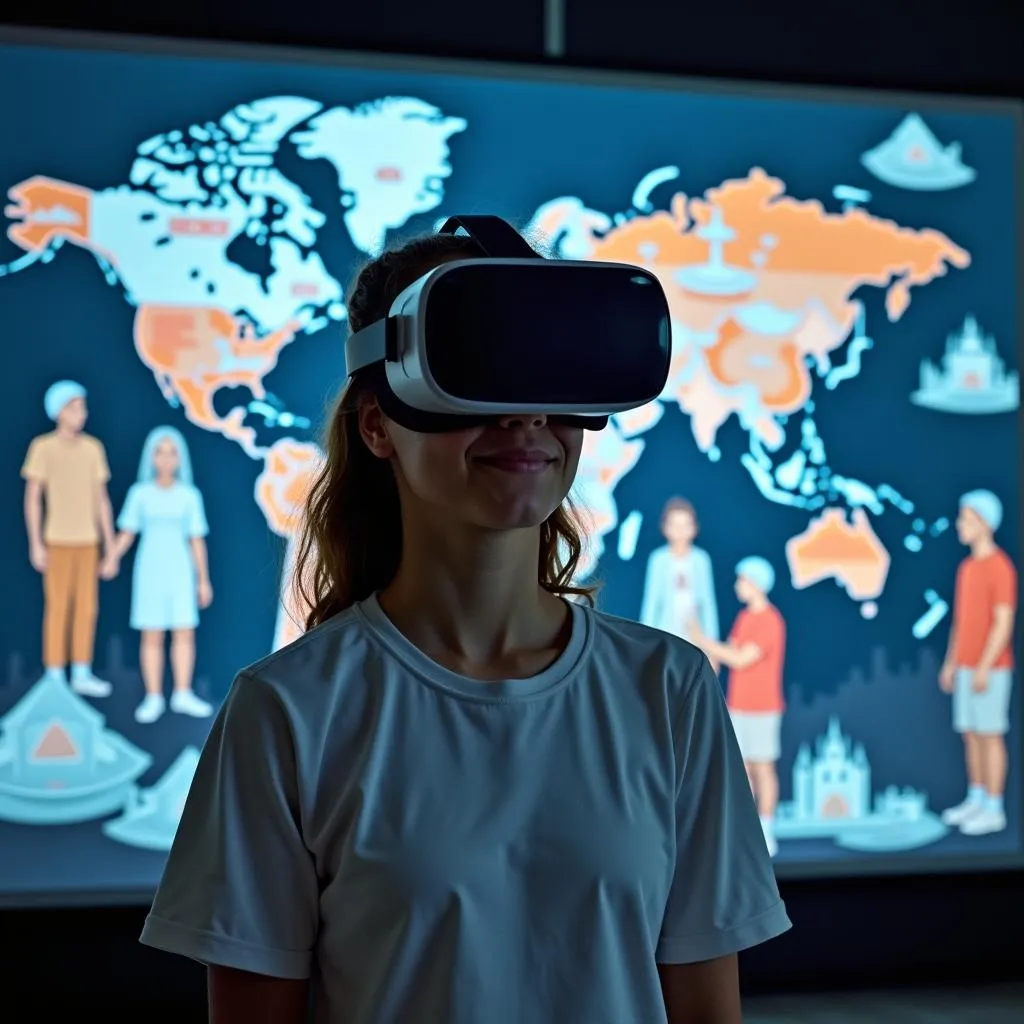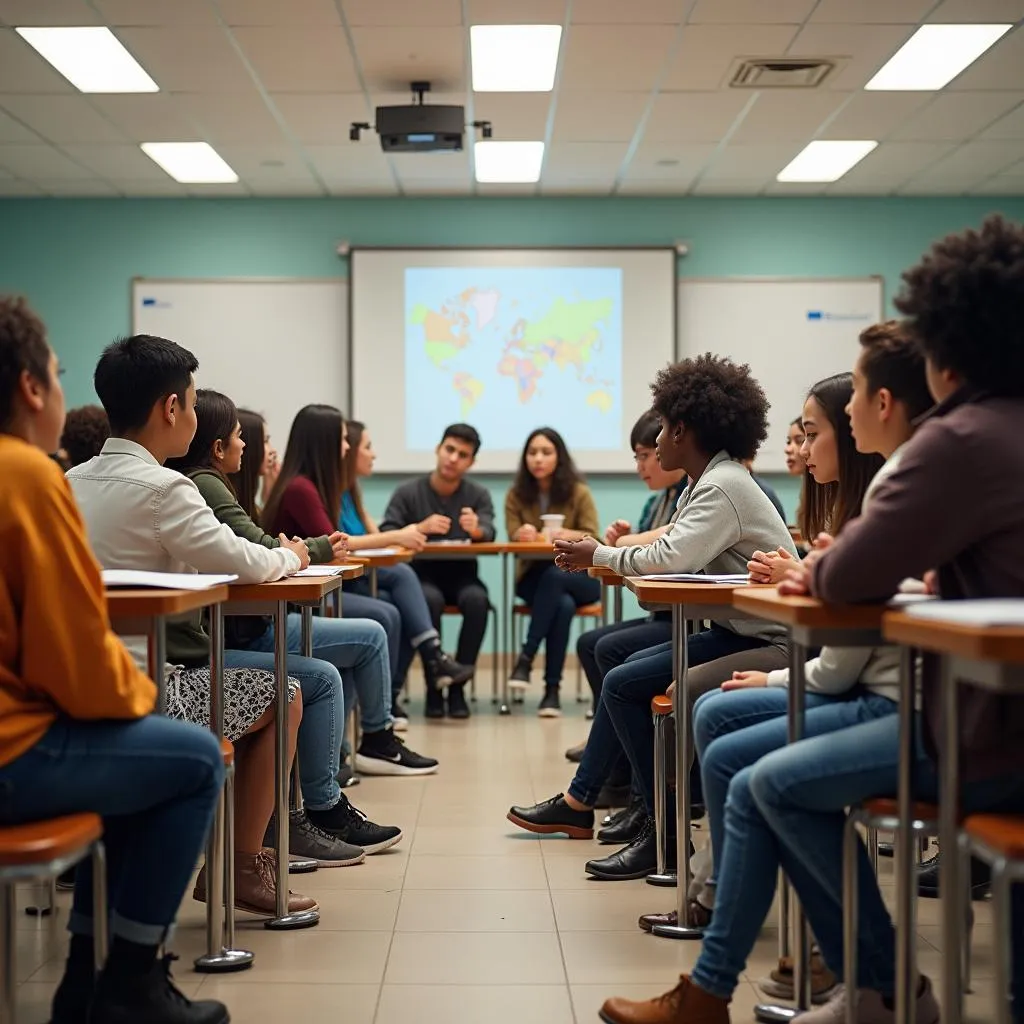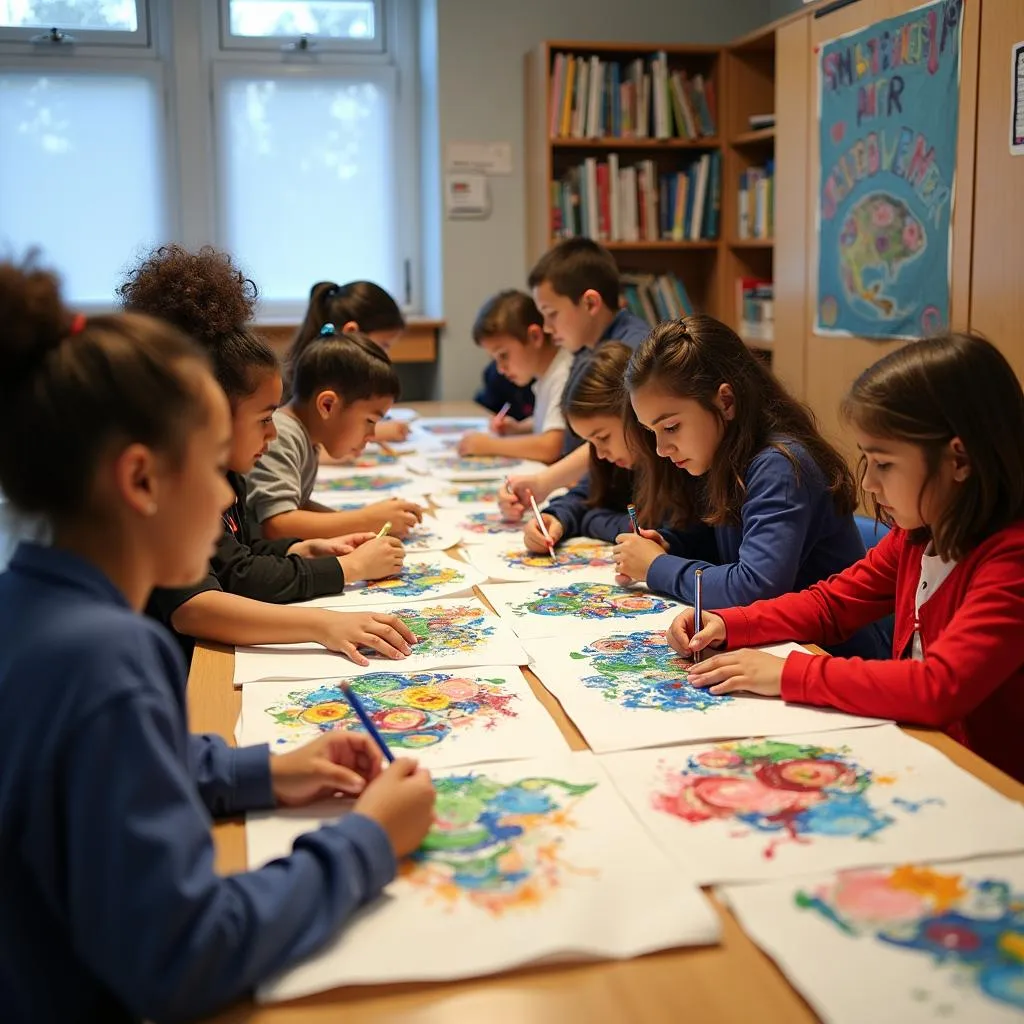The IELTS Reading test assesses your ability to understand and interpret complex texts on various topics. In this practice session, we’ll focus on how virtual learning platforms address cultural sensitivity, a crucial aspect of modern education. Let’s dive into three passages of increasing difficulty, followed by a range of question types to test your comprehension skills.
The role of cultural festivals in school community building is another interesting aspect of cultural education that complements virtual learning platforms. Now, let’s begin with our first passage.
Passage 1 (Easy Text)
Virtual Classrooms and Cultural Awareness
In recent years, the proliferation of virtual learning platforms has revolutionized education, making it more accessible and diverse than ever before. These platforms have not only bridged geographical gaps but have also become instrumental in addressing cultural sensitivity. By bringing together students from various backgrounds, virtual classrooms create a unique environment where cultural exchange happens organically.
One of the primary ways virtual learning platforms tackle cultural sensitivity is through customizable content. Unlike traditional textbooks, which often present a one-size-fits-all approach, digital platforms can tailor their materials to reflect different cultural perspectives. This adaptability ensures that students from diverse backgrounds can relate to the content, making learning more engaging and inclusive.
Moreover, these platforms often incorporate interactive elements that promote cultural understanding. For instance, virtual breakout rooms allow students to engage in small group discussions, sharing their unique cultural experiences and viewpoints. This peer-to-peer interaction fosters empathy and broadens students’ cultural horizons.
Another significant feature is the use of multimedia resources. Virtual platforms can easily integrate videos, podcasts, and interactive maps that showcase various cultures, traditions, and global perspectives. This rich, diverse content helps students develop a more nuanced understanding of cultural differences and similarities.
 Virtual learning platforms addressing cultural sensitivity
Virtual learning platforms addressing cultural sensitivity
Lastly, many virtual learning platforms offer real-time translation features, breaking down language barriers and facilitating communication between students who speak different languages. This not only aids in language learning but also promotes cross-cultural dialogue and understanding.
Questions 1-5
Do the following statements agree with the information given in the passage?
Write
TRUE if the statement agrees with the information
FALSE if the statement contradicts the information
NOT GIVEN if there is no information on this
- Virtual learning platforms have made education less accessible.
- Digital platforms can adapt their content to reflect different cultural perspectives.
- Virtual breakout rooms are used for formal assessments.
- Multimedia resources in virtual platforms help students understand cultural differences.
- All virtual learning platforms offer real-time translation features.
Questions 6-10
Complete the sentences below.
Choose NO MORE THAN THREE WORDS from the passage for each answer.
- Virtual classrooms create an environment where cultural exchange happens ____.
- Unlike traditional textbooks, digital platforms can ____ their materials to reflect different cultural perspectives.
- Virtual breakout rooms allow students to engage in ____ discussions.
- Multimedia resources help students develop a more ____ understanding of cultural differences.
- Real-time translation features break down ____ barriers between students.
Passage 2 (Medium Text)
Navigating Cultural Sensitivities in Virtual Education
The advent of virtual learning platforms has ushered in a new era of global education, bringing with it both opportunities and challenges in addressing cultural sensitivities. As these platforms transcend geographical boundaries, they must navigate a complex landscape of diverse cultural norms, values, and expectations. This task is far from trivial, requiring a delicate balance between providing universal access to knowledge and respecting cultural nuances.
One of the primary challenges virtual learning platforms face is the contextualization of content. What may be considered appropriate or relevant in one culture could be perceived as offensive or irrelevant in another. To address this, many platforms have adopted a modular approach to content creation. This method allows for the core educational material to remain consistent while enabling localization of examples, case studies, and contextual information. For instance, a lesson on business ethics might use different scenarios tailored to the cultural norms of various regions, ensuring relevance and sensitivity across diverse student populations.
Another critical aspect is the facilitation of cross-cultural dialogue. Virtual platforms often serve as melting pots of global perspectives, bringing together students from vastly different backgrounds. While this diversity is inherently valuable, it also poses the risk of cultural misunderstandings or conflicts. To mitigate these risks, many platforms incorporate cultural competency training for both educators and students. These programs aim to foster empathy, open-mindedness, and effective cross-cultural communication skills.
Cultural differences in approaches to conflict resolution in schools can provide valuable insights for virtual learning platforms in managing diverse student interactions.
The visual and auditory elements of virtual learning platforms also play a crucial role in cultural sensitivity. From color schemes to iconography, these elements can carry different connotations across cultures. Progressive platforms employ culturally neutral design principles and offer customization options to ensure that the learning environment is welcoming and inoffensive to all users. Similarly, the choice of voices for narration and the style of background music are carefully considered to avoid cultural biases.
 Cultural competency training in virtual learning
Cultural competency training in virtual learning
Furthermore, the assessment methods used in virtual learning environments must be culturally sensitive. Traditional Western-centric evaluation techniques may not always be appropriate or fair for students from different educational backgrounds. As a result, many platforms are exploring alternative assessment strategies that can accurately measure learning outcomes while respecting cultural differences in learning and demonstration of knowledge.
Lastly, the issue of language and translation remains a significant challenge. While automated translation tools have made great strides, they still struggle with nuances and context-specific meanings. To address this, leading virtual learning platforms are investing in human-assisted machine translation and culturally adaptive language learning modules to ensure that language barriers do not impede the learning experience or inadvertently cause cultural offense.
Questions 11-14
Choose the correct letter, A, B, C, or D.
-
According to the passage, one of the main challenges for virtual learning platforms is:
A) Providing universal access to the internet
B) Creating content that is culturally appropriate
C) Developing new technologies
D) Recruiting teachers from different cultures -
The modular approach to content creation allows for:
A) Complete customization of all educational material
B) Standardization of core content with localized examples
C) Elimination of all culturally sensitive topics
D) Separate courses for each cultural group -
Cultural competency training in virtual platforms aims to:
A) Teach students about a specific culture
B) Promote a single global culture
C) Develop skills for effective cross-cultural communication
D) Replace local cultural norms with international standards -
The passage suggests that traditional Western-centric evaluation techniques:
A) Are always the most effective
B) Should be used exclusively in virtual learning
C) May not be suitable for all students
D) Are easy to implement in virtual environments
Questions 15-20
Complete the summary below.
Choose NO MORE THAN TWO WORDS from the passage for each answer.
Virtual learning platforms face numerous challenges in addressing cultural sensitivities. One major issue is the need for (15) ____ of content to ensure relevance across different cultures. To facilitate cross-cultural understanding, many platforms offer (16) ____ for both educators and students. The visual and auditory elements of these platforms are designed using (17) ____ to avoid offending users from different backgrounds.
Assessment methods also need to be culturally sensitive, with platforms exploring (18) ____ that respect diverse educational backgrounds. Language barriers are addressed through (19) ____ and specialized language learning modules. Overall, these efforts aim to create a learning environment that is (20) ____ to all users, regardless of their cultural background.
Passage 3 (Hard Text)
The Paradigm Shift: Virtual Learning Platforms as Catalysts for Cultural Intelligence
The exponential growth of virtual learning platforms has catalyzed a paradigm shift in education, transcending the traditional boundaries of cultural exchange and sensitivity. These digital ecosystems have evolved beyond mere conduits of information to become sophisticated arbiters of cross-cultural dialogue and understanding. As they continue to reshape the educational landscape, these platforms are increasingly recognized as pivotal in cultivating what scholars term “cultural intelligence” (CQ) – the capability to function effectively across a variety of cultural contexts.
The multifaceted approach adopted by cutting-edge virtual learning platforms in addressing cultural sensitivity is rooted in the recognition that culture is not a monolithic entity but a complex, dynamic system of shared beliefs, values, and practices. This nuanced understanding has led to the development of adaptive learning algorithms that not only respond to individual learning styles but also to cultural predispositions in cognitive processes. For instance, some platforms employ machine learning techniques to analyze patterns in user interactions, adjusting the presentation of material to align with culturally influenced learning preferences, such as the balance between individual and group-based activities or the emphasis on rote learning versus critical inquiry.
Moreover, these platforms are increasingly incorporating ethnographic methodologies into their design processes. By engaging in deep, contextual research across diverse cultural settings, developers are able to unearth subtle cultural nuances that might otherwise go unnoticed. This approach has led to the creation of culturally responsive interfaces that go beyond superficial localization efforts. For example, some platforms now offer dynamically generated metaphors and analogies that draw from a user’s cultural background, making abstract concepts more relatable and comprehensible.
The impact of global news on students’ cultural perceptions is another factor that virtual learning platforms consider when designing culturally sensitive content and experiences.
The integration of virtual reality (VR) and augmented reality (AR) technologies has opened up new frontiers in culturally sensitive education. These immersive technologies allow for the creation of simulated cultural environments, providing students with the opportunity to experience and navigate diverse cultural contexts in a safe, controlled setting. This experiential learning approach not only enhances cultural awareness but also fosters empathy and reduces the potential for cultural misunderstandings in real-world interactions.
 Virtual reality cultural immersion in education
Virtual reality cultural immersion in education
Furthermore, the rise of peer-to-peer learning models within these platforms has democratized the process of cultural exchange. By facilitating direct interactions between students from diverse backgrounds, these platforms create opportunities for authentic cultural dialogues that challenge preconceptions and promote mutual understanding. Some advanced systems employ natural language processing (NLP) algorithms to monitor these interactions, providing real-time guidance to help students navigate potential cultural pitfalls and misunderstandings.
The ethical implications of such technologically mediated cultural exchanges have not gone unnoticed. Critics argue that the algorithmically curated cultural experiences provided by these platforms risk creating a sanitized, oversimplified version of cultural diversity. In response, leading platforms are actively collaborating with cultural anthropologists and ethicists to develop frameworks for ethical cultural representation in digital learning environments. These efforts aim to strike a balance between making cultural content accessible and preserving the complexity and dynamism of real-world cultural interactions.
As virtual learning platforms continue to evolve, they are increasingly focusing on developing metacognitive skills related to cultural intelligence. This involves not just exposing students to diverse cultural content but also teaching them to reflect on their own cultural biases and assumptions. Some platforms have introduced guided reflection modules that prompt students to analyze their reactions to culturally diverse material, fostering a deeper level of self-awareness and cultural sensitivity.
In conclusion, the role of virtual learning platforms in addressing cultural sensitivity has expanded far beyond simple content localization. These platforms are now at the forefront of a global effort to cultivate cultural intelligence, leveraging cutting-edge technologies and pedagogical innovations to create more inclusive, empathetic, and culturally aware learning environments. As they continue to evolve, these platforms hold the potential to not only bridge cultural divides in education but also to contribute significantly to the development of a more culturally intelligent global citizenry.
Questions 21-26
Complete the summary below.
Choose NO MORE THAN THREE WORDS from the passage for each answer.
Virtual learning platforms have become (21) ____ of cross-cultural dialogue, playing a crucial role in developing cultural intelligence. These platforms use (22) ____ to adjust content presentation based on culturally influenced learning preferences. Some platforms incorporate (23) ____ in their design process to uncover subtle cultural nuances. The integration of VR and AR technologies allows for the creation of (24) ____, providing safe environments for cultural navigation.
To address ethical concerns, platforms are working with experts to develop frameworks for (25) ____ in digital learning environments. Additionally, these platforms are focusing on developing (26) ____ related to cultural intelligence, helping students reflect on their own cultural biases.
Questions 27-32
Do the following statements agree with the claims of the writer in the passage?
Write
YES if the statement agrees with the claims of the writer
NO if the statement contradicts the claims of the writer
NOT GIVEN if it is impossible to say what the writer thinks about this
- Virtual learning platforms have completely replaced traditional methods of cultural exchange.
- Adaptive learning algorithms can respond to both individual learning styles and cultural predispositions.
- All virtual learning platforms now offer dynamically generated metaphors based on users’ cultural backgrounds.
- The use of VR and AR in cultural education is limited to visual representations only.
- Peer-to-peer learning models in virtual platforms have made cultural exchange more democratic.
- The development of metacognitive skills related to cultural intelligence is the primary focus of all virtual learning platforms.
Questions 33-36
Choose the correct letter, A, B, C, or D.
-
According to the passage, cultural intelligence (CQ) refers to:
A) The ability to speak multiple languages
B) Knowledge of different cultural customs
C) The capability to function effectively in various cultural contexts
D) The skill of teaching about different cultures -
The passage suggests that ethnographic methodologies in platform design:
A) Are only used by a few platforms
B) Help in creating more culturally responsive interfaces
C) Are not effective in digital environments
D) Focus only on major cultural differences -
The criticism mentioned in the passage regarding algorithmically curated cultural experiences is that they:
A) Are too technologically advanced for most users
B) Do not include enough cultural content
C) May oversimplify cultural diversity
D) Are too expensive to implement widely -
The guided reflection modules mentioned in the passage aim to:
A) Test students’ knowledge of different cultures
B) Encourage students to analyze their own cultural biases
C) Teach students about specific cultural practices
D) Prepare students for international travel
The integration of digital art in teaching cultural history represents another innovative approach that virtual learning platforms could explore to enhance cultural sensitivity and engagement.
Answer Key
Passage 1
- FALSE
- TRUE
- NOT GIVEN
- TRUE
- NOT GIVEN
- organically
- tailor
- small group
- nuanced
- language
Passage 2
- B
- B
- C
- C
- contextualization
- cultural competency training
- culturally neutral design principles
- alternative assessment strategies
- human-assisted machine translation
- welcoming
Passage 3
- sophisticated arbiters
- adaptive learning algorithms
- ethnographic methodologies
- simulated cultural environments
- ethical cultural representation
- metacognitive skills
- NO
- YES
- NOT GIVEN
- NOT GIVEN
- YES
- NO
- C
- B
- C
- B
The rise of storytelling platforms in cultural learning is an additional aspect that complements the efforts of virtual learning platforms in addressing cultural sensitivity, offering narrative-based approaches to enhance cultural understanding.


